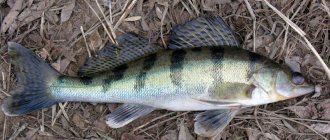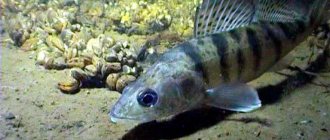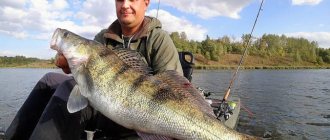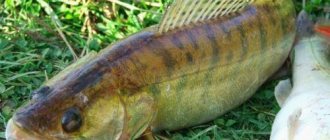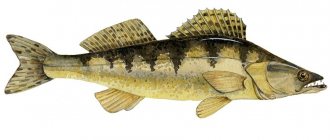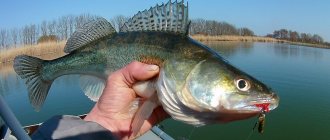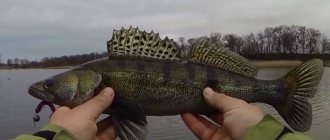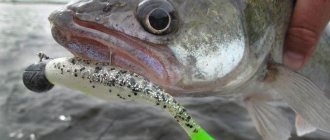Bersh is a fish from the perch family, very similar in appearance to pike perch, but does not grow to such a large size. It is prized by fish for its tender and juicy meat, although it is not caught on an industrial scale. It leads a school life and hunts fry, and young individuals often swim in reservoirs next to pike perch.
Bershis are found in fresh water bodies of Russia
Appearance and size of fish
Dark symmetrical stripes on the body are the first sign by which the bersha can be distinguished from other fish from the perch family. This is a small fish, reaching a length of up to 45 cm, while its body weight does not exceed 1.4 kg. The long body is abundantly covered with scales, the fins are large in size, the two front ones consist of bone spines united by a membrane.
Looks like a small pike perch
Bersh and pike perch: description and habitat
Quite often, when fishing on the Volga, Oka or Dnieper, a bersh, very similar to a pike perch, is caught on a hook. In size, this fish is significantly inferior to pike perch and quite rarely reaches a weight of eight pounds .
Bersh
This schooling predatory fish prefers clear water, moderate currents and sandy, pebble or rocky bottoms.
- Large-sized bersh live almost on the fairway, young ones live near the shore, but always at the bottom.
- Juveniles sometimes stay close to schools of pike perch.
- The dimensions of the bersh are small: its weight is from 1.2–1.5 kg, its length is about 45 cm.
- Fish live in schools and hunt fry. They are capable of swallowing prey no more than 7 cm long.
- Habitat: Volga River and its tributaries, Caspian Sea.
- Bersh spawns in the spring, sticking to deep sandy places.
- It is actively caught in the first half of the day and takes jigs and all types of light-colored jigs.
- Recently, the number of this fish species has increased significantly.
Bersh is a completely ordinary fish that is suitable for frying, boiling and fish soup .
Zander
This largest representative of the perch family lives in lakes and rivers.
- The elongated body of the fish is covered with small scales with jagged edges, which partially extend to the tail and head.
- The dorsal fins touch each other or are separated by a small gap.
- All rays of the first dorsal fin are spiny, while the second has only three spiny rays.
- The fish has elongated jaws and a large mouth with numerous small teeth.
- There are spines on the gill bones of pike perch, and fangs on the jaws.
- Its belly is white, its back is greenish-gray, and there are up to ten transverse black-brown stripes on its sides.
- The ventral, pectoral and anal fins of pike perch are pale yellow.
- The membranes of the caudal and dorsal fins are dotted with dark spots.
Bersha habitats
The pike perch brother prefers clean reservoirs with moderate currents. It does not go to the open sea; it swims only in fresh water. Large individuals live in deep water, and fry live in shallow water.
Bersh is not found anywhere in large quantities, but individual specimens can be found in rivers flowing into the Azov, Caspian and Black Seas; Volgograd, Kuibyshev and Tsimlyansk reservoirs, Baltic Bay. Most often, bershas are caught in the Volga. They love warm water and choose to live in places in the reservoir located closer to the south. Low oxygen levels suffocate, so this fish is not found in muddy, muddy lakes.
Description of Bersh fish
Today there is little information about the Bersh fish, since many novice fishermen confuse this individual with pike perch, which can be caught so successfully both on the shores of the Black Sea and the Caspian Sea. But at the same time, you can meet pike perch and Bersh on the shores of the Azov Sea, but only in rare cases. Therefore, it is worth paying more attention to the study of appearance. And so as not to confuse these types of fish and understand in more detail what type of fishing to prepare for and what gear is better to choose. Also an important aspect will be understanding the time of catching, which differs minimally for these individuals, but is still present.
What is the difference between bersh and pike perch?
The habitat, food supply and even appearance of these two representatives of the perch family are largely similar, so they are often confused. But an experienced fisherman can easily name the main differences between bersh and pike perch:
- the bersh has small teeth in its mouth, and the pike perch has fangs;
- has a more modest weight - up to 1.5 kg, while its older brother - pike perch - can reach up to 15 kg;
- the gill is completely covered with small scales;
- the head is short and wide, and the eyes are larger than those of the older brother;
- the stripes on the body are dark and symmetrically located;
- fewer transverse stripes - only 8;
- the scales are larger - the bersh has 70-75 rows, and the pike perch has 80-90;
- pike perch stays at a depth of 10 m, and an adult bersh usually goes under water to 14 m;
- shorter lateral line.
The differences between these two species are obvious:
Bersh can hunt for its prey at any time of the day, while pike perch goes hunting only at night.
The absence of fangs also makes some adjustments to the fish’s lifestyle - they choose smaller prey for food, no more than 7 cm in size.
How to distinguish pike perch from bersh
The difference between fish lies not only in appearance. Representatives of the same family also have different habitats and spawning periods. There are also some peculiarities in catching “relatives”.
External features and dimensions
Comparing the two fish in detail, it is easy to notice the difference in appearance:
- Unlike pike perch, bershik does not reach trophy sizes - the maximum body length of this fish is 45 cm, and its weight is 1.4 kg.
- Pike perch have sharp, large fangs on the lower and upper jaws. Its Volga counterpart does not have them - its mouth is studded with small sharp teeth of the same length.
- The gill cover and cheeks of bershas are covered with small scales.
- The Volga pike perch has a more rounded, larger head with a wide snout and larger eyes.
- The body is covered with 75 rows of large scales.
- The younger brother differs from the fanged one in having a lighter body color with clearly visible transverse black stripes. It also has a darker back.
In poor lighting, you can distinguish the bersh from its ordinary brother in the following way - just carefully run your finger along the gill cover and cheeks of the caught fish. If at the same time you feel as if your finger is sliding along fine sandpaper, it means that you have caught a bershik.
The method is based on the presence of small scales on the cheeks and gill cover of this fish. It is about them that the finger clings.
We recommend reading: Carp fish, description of the species
Habitat
Although these two species are often found in the same bodies of water, their habitats are slightly different:
- Bershis live in the rivers of the Azov, Black, and Caspian seas. Unlike pike perch, these fish prefer warmer waters. The main population lives in the middle and lower reaches of the Volga. There is a lot of this river predator in the mouth of the great Russian river.
- Pike perch, unlike its Volga counterpart, is more hardy and less demanding on water temperature. It is widespread not only in the southern regions of Russia, but also in reservoirs of Siberia and the Far East.
Within the same reservoir, the habitats of these species are very similar. They are attracted to river holes, whirlpools, and channel ditches of reaches with a depth of 4-5 to 20-25 m. Small bershi very often live together with medium and large perch. Especially in thickets of aquatic vegetation or coastal snags.
Unlike pike perch, bersh is found in coastal desalinated areas of the Caspian and Black Seas. Also, this species is less common in bodies of water with standing water.
Reproduction
These two species also differ in terms of spawning:
- pike perch spawns from early April to mid-May at water temperatures above +10 C;
- Bersha spawning occurs a little later, from mid-April to mid-May.
Their spawning places are the same - areas with weak currents, clay or pebble bottom. At the same time, the Volga pike perch has an undeveloped parental instinct: after spawning, the male does not guard the clutch of eggs.
Fishing Features
The differences in fishing methods for these two species are not as significant as in appearance, habitat and timing of spawning:
- Common pike perch is caught in holes and pools using spinning rods and mugs. To catch pike perch using a spinning rod, artificial baits such as heavy oscillating spoons, twisters, vibrating tails made of edible silicone, and diving minnow-class wobblers are used. For mug fishing, juveniles of narrow-bodied fish species - bleak, perch, roach, gudgeon, dace - are used as live bait.
- In bersh fishing, in addition to spinning rods, circles and girders, they often use a live bait float rod and bottom tackle. Small bershik can also be caught on a regular fishing rod with a large dung worm.
Recommended reading: Don Ruff
In winter, both species can be caught well with vertical spoons, balance beams and girders.
Video: bersh and pike perch - 14 distinctive features
What does a river predator eat?
Bersch bites in spring and autumn. Winter fishing rarely brings a catch, since the fish hide under snags at the bottom and practically do not feed. The basis of the food is small fish, mainly gudgeon, but also fry of other fish species often become prey for predators.
Bersh are caught using live bait or using a variety of fishing gear - spinners, twisters, and jigs are used.
For your fishing to be successful, you need to know some secrets of catching bersh:
- the fishing line should be of medium thickness;
- It is better to choose a large and elongated jig;
- sprat, perch, and gudgeon are used as live bait.
The fish bite actively in the mornings, until 12 noon. After this, small specimens of pike perch are usually caught on a fishing rod or spinning rod. During winter fishing, you need to use an inertial reel, and for bait, bloodworms, worms, and larvae are suitable. Catching bersh is not an easy task, so the caught fish is considered a real trophy.
Bersh is a desirable catch for any fisherman
Note! Bersh is listed in the Red Book, so before fishing you need to check whether it is prohibited in your region.
Common pike perch
The differences between pike perch and bass are important for any angler. Only by thoroughly studying the habits of two predators can you successfully catch one or another fish. There is much more information about pike perch.
On the Don and the coast of the Azov Sea, people call it sula. Knowing the habits of pike perch, you can choose the right feeding, tackle, bait and place for fishing. The result is a rich catch and a good mood.
The range of the common pike perch is quite wide. It can be caught in rivers flowing into seas and lakes such as:
- Baltic.
- Caspian.
- Azovskoe.
- Aral.
- Black.
- Issyk-Kul.
- Balkhash.
- other bodies of water.
This fish is quite large. There is evidence of catches of individuals more than a meter long and weighing 15 kg. It is quite possible that even larger specimens exist.
A characteristic feature of this fish is the presence of fang-shaped teeth, giving it a ferocious appearance. Females look more modest, their fangs are shorter than those of males.
Appearance
There are several varieties of this fish, differing in the color of their scales and the shape of their fins. All of them have an elongated fusiform body, laterally compressed. The scales are small, with uneven jagged edges and sit firmly in the skin. The scaly cover covers part of the head and tail. The lateral line extends onto the caudal fin. There are two fins on the back, they are either separated by a short distance or touch each other.
In one dorsal fin, which is closer to the head, all the rays are hard and spiny. In another - only 1-3, the rest are soft. The same “spines” are present in the anal fin and two ventral fins. The membranes of the fins on the back and tail are dotted with small spots of dark color.
The back is greenish-gray, darker closer to the fins. The belly is white or gray. Transverse stripes are clearly visible on the sides. They are brown-black, up to 10 or more pieces.
Spawning season and its features
Bersh becomes sexually mature in the 4th year of life, spawns in the spring - in April-May. Females are distinguished by their fertility and during one spawning they lay up to 500 thousand small eggs of light yellow color. The bersh lays its eggs in specially equipped nests on the sandy bottom; usually they are located within an abandoned snag. After laying eggs, the female leaves the nest, and the males remain to guard it until the larvae hatch.
After about a week, the eggs hatch, but small eggs remain in the cocoon and eat the remains of the shell. After 5 days, the larvae turn into fry, leave the nest and begin to feed on zooplankton. Small bershes eat invertebrates in unlimited quantities.
